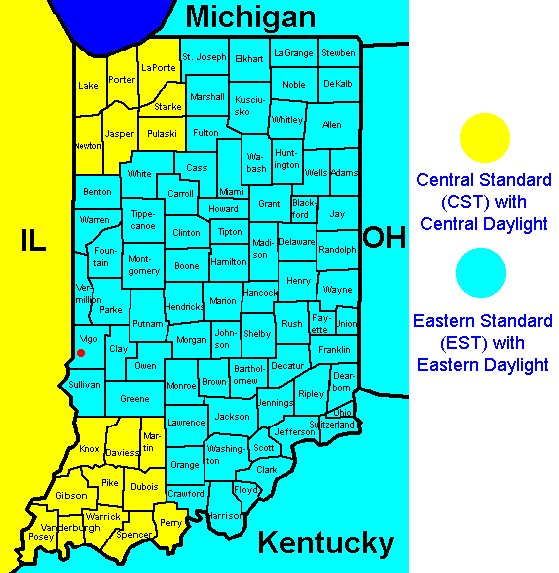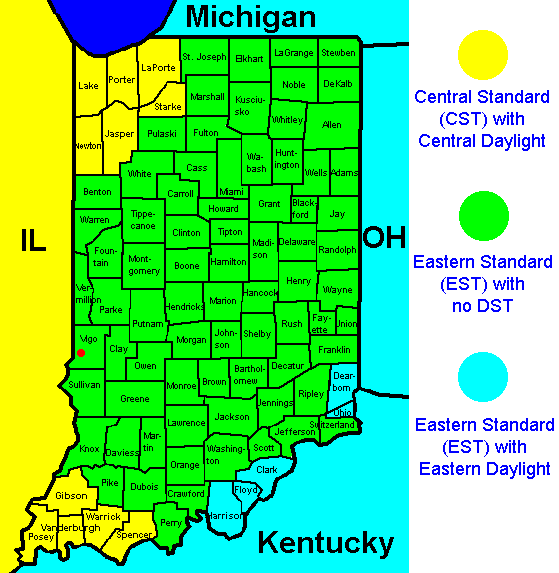
A history and guide to Terre Haute - Differences 3
 |
 |
Differences and First Impressions (1)
Time
Here's an interesting question - What's the time?
This was originally written in March 2004 but in April 2005 the state legislature decided that Daylight Saving Time would be introduced statewide on 2nd April 2006. Indiana time is still messed up though as 18 counties are on Central Daylight Time and the remaining 74 are on Eastern Daylight Time. The time map of Indiana now looks like this...

County map with time zones in and around Indiana (after April 2006)
But this is a very recent change. Before I started visiting Patty, when we were chatting online, it was obvious that Indiana, which is on Eastern Standard Time, was a couple of hours behind us, because of British Summer Time that time difference was six hours in the summer, and five in the winter. On my visits, before I moved here permanently, I knew that Illinois was on Central Standard Time which is an hour behind EST. As Terre Haute is close to the border with Illinois, those people who live and work in the different states find themselves losing and gaining an hour to and from work. That was odd enough, but when I moved here I realised that it is even more complicated. Terre Haute does not use Daylight Saving Time, but other counties in Indiana do. This means that some counties are on Central Standard Time and others are on Eastern Standard Time, some with Daylight Saving Time and some without.

County map with time zones in and around Indiana (before April 2006)
The UK is in the Western European Time Zone. Western European Standard Time (WET) is Greenwich Mean Time (GMT). Like most states in Europe, Summer (Daylight Saving) Time is observed in UK, where the time is shifted forward by 1 hour; 1 hour ahead of Greenwich Mean Time (GMT+1). After the Summer months the time is shifted back by 1 hour to Western European Time (WET) or (GMT). Summer time is known as British Summer Time (BST)
The time differences are also complicated by the fact that BST starts at a different time than CDT and EDT. In the UK BST starts the last Sunday in March, CDT and EDT start on the first Sunday in April. They all end on the last Sunday in October.
To summarize :- BST = GMT+1, CST = GMT-6, CDT = GMT-5, EST = GMT-5, EDT = GMT-4
| Month | Terre Haute (Indiana) | Chicago (Illinois) | Ohio / Kentucky / Michigan |
| EST no EDT | CST with CDT | EST with EDT | |
| January | -5 | -6 | -5 |
| February | -5 | -6 | -5 |
| March * | -5 (-6) | -6 (-7) | -5 (-6) |
| April | -6 | -6 | -5 |
| May | -6 | -6 | -5 |
| June | -6 | -6 | -5 |
| July | -6 | -6 | -5 |
| August | -6 | -6 | -5 |
| September | -6 | -6 | -5 |
| October | -6 | -6 | -5 |
| November | -5 | -6 | -5 |
| December | -5 | -6 | -5 |
* Minus an hour in this row from the last Sunday in the March to the first Sunday in April (figure in brackets).
Table of hours difference in local times from the UK (GMT + BST)
Writing this piece I got myself thoroughly confused. For more information on time zones, daylight saving and the history of daylight saving time please see the following sites
Daylight Saving Time (University of Illinois) *
Daylight Saving Time (Web Exhibits)
History of legal time in Britain
US Naval Observatory (Time Service Department)
Hoosiers
People from Indiana are not called Indianians they are called Hoosiers and Indiana is called the Hoosier State. What is a Hoosier? The Indiana Historical Society give several origins. My favourite is by "The Hoosier Poet," James Whitcomb Riley. He claimed that Hoosier originated in the pugnacious habits of our early settlers. They were enthusiastic and vicious fighters who gouged, scratched and bit off noses and ears. This was so common an occurrence that a settler coming into a tavern the morning after a fight and seeing an ear on the floor would touch it with his toe and casually ask, "Whose ear?"
The correct definition was probably found by Jacob Piatt Dunn, Jr., Indiana historian and longtime secretary of the IHS. Dunn noted that "hoosier" was frequently used in many parts of the South in the 19th century for woodsmen or rough hill people. He traced the word back to "hoozer," in the Cumberland dialect of England. This derives from the Anglo-Saxon word "hoo" meaning high or hill. In the Cumberland dialect, the world "hoozer" meant anything unusually large, presumably like a hill. It is not hard to see how this word was attached to a hill dweller or highlander. Immigrants from Cumberland, England, settled in the southern mountains (Cumberland Mountains, Cumberland River, Cumberland Gap, etc.). Their descendents brought the name with them when they settled in the hills of southern Indiana.
April is the start of mushroom season here. Hoosiers go trampling through the woods looking for these elusive fungi. I've heard several people saying that the definition of a Hoosier is someone who bounces a basketball around the Indy 500 track looking for mushrooms.
This page created 13th December 2001, last modified 6th February 2007